 67 manual idler arm 5.8"
67 manual idler arm 5.8"Look how close the brake lines are to the pitman arms below.
 67 manual idler arm 5.8"
67 manual idler arm 5.8"
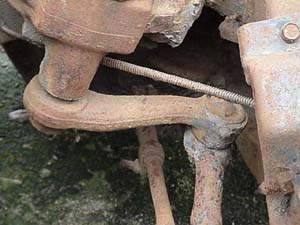
67 manual pitman arm 5.8"
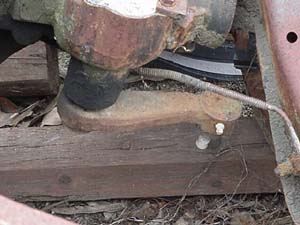 "68 power short pitman 5.25"
"68 power short pitman 5.25"
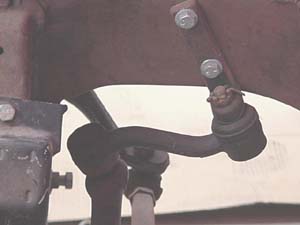 68-69 replacement "L" bracket type short idler arm 5.25"
68-69 replacement "L" bracket type short idler arm 5.25"
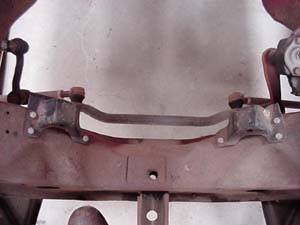 A
shot of our 69 Camaro race car with a manual long 5.8" pitman arm and
a short 5.25" Idler arm. Note the center link is not parallel to the
cross member. there is a wider gap on the left hand side of the
photo, the passenger side of car. This Camaro has been upgraded with
circle track tie rod ends that are very large and heavy duty,
Chrysler screw in lower ball joints, Chevy truck upper ball joints,
Stock Car Products spindles, Airheart 12" disc brakes.
A
shot of our 69 Camaro race car with a manual long 5.8" pitman arm and
a short 5.25" Idler arm. Note the center link is not parallel to the
cross member. there is a wider gap on the left hand side of the
photo, the passenger side of car. This Camaro has been upgraded with
circle track tie rod ends that are very large and heavy duty,
Chrysler screw in lower ball joints, Chevy truck upper ball joints,
Stock Car Products spindles, Airheart 12" disc brakes.
A stock 67-68 PS box will give over 4.5 turns lock to lock when it is out of the car. When installed it will be less, especially if you have the long pitman arm, and the short PS outer arms.
The 69 variable ratio PS box is about 2.3 turns lock to lock out of the car.
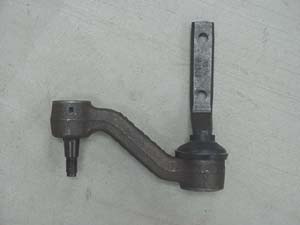 This
is a Moog k6099 replacement idler arm for 68-69, length is 5.375"
center to center, so it's somewhat in-between a 67 length and a 68/69
length.
This
is a Moog k6099 replacement idler arm for 68-69, length is 5.375"
center to center, so it's somewhat in-between a 67 length and a 68/69
length.

Left is a stock 69 idler arm, right is a currently available Moog K6099 idler arm. The replacement is described above. I bolted them together and laid a straight edge across them to compare the height of the cener link attachments.
There are two lengths, the short Pitman is 5.25" long center to center.
It seems the long pitman was used on all? 67, Camaros with no short option.
The long 5.8" and short 5.25 were used on the 68 and 69, both manual and power steering.
The 5.8" being used for the fast ratio steering option.
Above that, there was the special fast ratio steering for the Z/28 only, both manual and power.
I've been investigating the idler arm differences.
As far as I can tell the 67's used a long idler about 5.8" long.
The 68-69 used an idler about 5.25" long.
I haven't seen a 69 that uses a long idler, if anyone has a long idler on a 68 or 69 please let me know.
The replacement MOOG #K-6099 idler arm (square shaped arm) is 5.375" long.
I currently have this moog idler on my 69 with the long manual pitman.
The center link looks a little out of parallel with the cross member. I have heard there is some difficulty bolting the center link up to the long arm and short pitman as they don't line up perfectly, and it puts them in a bind somewhat.
I'll find out more when I change it over to power steering.
I think it will work OK but I don't understand why Chevrolet didn't use the 67 long idler on the 68 and 69 with long pitman.
As far as geometry goes, I don't think there is a problem using either idler with either pitman.
UPDATE: Super Chevy did an article on bump steer and different steering components on the Camaro. Oct 2000 issue.
It seems the 68 and 69 camaros used different outer tie rods.
All steering arms are different threads, left and right are different "handed".
The 67 outer tie rod threaded shank is listed as aprox a half inch shorter than a 68/69 part.
BOTTOM- 69 PS long pitman arm fast ratio 5.8" GM#3953227
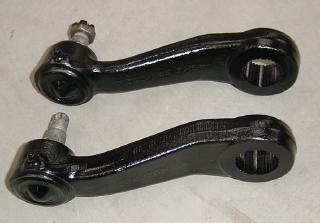
Here is the way to find out your steering box ratio. This is the box ratio not the overall ratio listed on the option sheet.
Place a degree wheel on the output shaft and turn the input shaft exactly one turn.
DEGREES -------RATIO
22.5 ------16.2
25 --------14.4
29 --------12.4
Some boxes are variable ratio and will give different degrees per turn depending on what part of the travel you are on.
I have a 67 and a 69 box that is the 5691676 casting number, they have different ratio gears from each other.
The steering box ratio is shown by an ink stamped two letter mark on the aluminum top cover near the lash adjust screw other numbers on the box do not tell the ratio.
The 12 to 1 ratio box was only used starting with the 1982 up Z/28 and TA or IROC.
The IROC has a stiffer spool valve for even higher steering effort than the Z/28.
The fastest ratio box before 1982 was a 14 to 1. This box gave a 13 to 1 OVERALL RATIO when in the car due to the steering linkage increase, (longer pitman arm) making it equal to the third gen 12 to 1 ratio.
Here is a link to the Chevelles.com site Tech Reference section on Power Steering. Lots of steering box rebuild info here: http://www.chevelles.com/techref/ftecref29.html
The steering box ratio relates number of turns of input shaft (steering wheel) to complete one turn of output shaft .
(Here is my 12.7 to 1 PS box rebuilt by Lee Manufacturing. Lee Manufacturing
You can measure steering output degrees per input turn as shown above. The rusty wire at the top of the photo is my pointer, it is held to the box by the vise grip pliers. The degree wheel is just laying there it is not bolted to the shaft but some weight on it will help it stay put.
FORMULA:
Degrees of output shaft / turns of input shaft = deg per turn
360 divided by deg per turn = box ratio.
EXAMPLE: This box has 85 degrees in 3 turns, divide the 85 by 3, which equals 28.3 degrees per input turn. 360 degrees divided by 28.3 = 12.7208 turns, which means you have the 12.7 to 1 ratio box.
In other words, you would have to turn the steering wheel 12.7 turns to make the output shaft go 1 revolution.
VARIABLE RATIO BOX READINGS
If you suspect you have a variable ratio box,, first center the steering box, make the pitman arm point towards the end plug of the box, - straight forward. back off the input shaft a half turn counter-clockwise, then begin your readings, set deg wheel to Zero, thrn the input clockwise shaft back to center, then a half turn past center, stop and read degrees.
This ratio would be multiplied by the linkage ratio to arrive at "overall ratio" at the wheel.
Here is a printable degree wheel - FREE http://www.tavia.com/free_degree_wheel.jpg
NOTE: the ratio numbers change a bit from article to article. I've seen 12 to 1, 12.4 to 1, and 12.7 - to 1 I think they are all talking about the same ratio, and I think the 12.7 is more correct according to what my box measures.
The steering linkage adds an additional multiplier to the basic box ratio to arrive at an overall ratio. It could be a positive or negative multiplier (number less than one - a decimal).
Pitman arm long - 5.8", short- 5.25" These measurements are fairly accurate.
Outer steering arms - short 5.25", medium 5.75", long outer steering arm, is roughly 6.2" long. These are pretty close, I may revise by 1/8" + -
The factory sales brochure for 1967 shows power steering ratios of 17.5, to 1, - the "fast steering"15.6 to 1.
N40 = Power steering option
N44 = Fast ratio option (could be ordered on manual or power steering)
On Z/28 only, got a "special fast ratio" MANUAL STEERING option that was faster than normal N44 fast ratio.
1969 used a variable ratio power steering box.
|
|
|
|
|
|
|
|
|
|
|
|
|
|
|
|
|
|
|
|
|
|
|
|
|
|
|
|
|
|
|
|
|
|
|
|
|
|
|
|
|
|
|
|
|
|
|
|
|
|
|
|
|
|
|
|
|
|
|
|
|
|
|
|
|
|
|
|
|
|
|
|
|
|
|
|
|
|
|
|
|
|
|
|
|
|
|
|
|
|
|
|
|
|
|
|
|
|
|
|
|
|
|
|
|
|
|
|
|
|
|
|
|
|
|
|
|
|
aftermarket 12.7 gear conversion |
|
|
|
|
|
|
|
|
12.7:1 gear conversion |
|
|
|
|
|
|
|
? = is my best guess, probably close. The 67/68 chart is NOT CORRECT YET! I'm still working on this data to include the medium length outer arms.
I believe the slow ratio PS used the medium outer arm and fast ratio used the short outer arm.
I'm pretty sure these arm combinations were used, but not sure of the box ratios used.
|
|
|
|
|
|
|
|
|
|
|
|
|
|
|
|
|
|
|
|
|
|
|
|
|
|
|
|
|
|
|
|
|
|
|
|
67/68 PS chart is not correct yet
69 is pretty close
The model box that fits a first gen camaro is the Saginaw #800.
ID codes are ink stamped on the box with two letters, cast or stamped numbers are of no use for Id other than year of manufacture.
Here is a link to many GM steering box ID codes! http://www.chevelles.com/techref/shea_3.html
There is a date code stamped on the aluminum top cover, it will be in Julian date form. Julian date is a secquential date from 1 to 365 starting from the first day of the year to last day. A box stamped 142-9 would be the 142nd day of 1969. If you look on the internet, you can find Julian callanders.
The piston bore size should be 3 7/8" NOT the big car and pickup 4 1/4".
PS boxes have a larger output shaft dia than manual boxes, use a PS pitman only.
Use only a first gen Camaro, Firebird, or up to 74 Nova PS pitman. You can't use any of the late pitman arms on an early Camaro.
According to articles, pre 1980 boxes have a .760" input shaft, 1980 and up boxes have a smaller .670" shaft and require a smaller coupler #7826542 from a 77-86 pickup. Pinch bolt #7807271 is used with the coupler.
Here is a listing of production GM vehicles that have flexible couplings that will adapt your steering column to the new steering gear with a 3/4 input shaft.
1977 thru 1982 Chevrolet and GMC C/K (2 wheel and 4 wheel drive) Pickup Trucks
1977 and 1978 Camaro, Firebird, and Nova
1979 Nova
1983 thru 1986 Chevrolet and GMC C (2 wheel drive only) Pickup Trucks
My 67 PS box has a .800" (large) OD input shaft. the measurements above from magazine may be ID of coupler??? Some articles say early is 13/16" , late boxes have 3/4".
Pre-1980 used standard inverted flare fittings on the box. 1980 and up boxes (maybe 81 up) use a special fitting with an O ring seal. Adapters are available from Lee Manufacturing, call 818 / 768 / 0371
Power steering pumps use three types of output fittings, the 60's standard 45 deg flare with male end on the pump, the 70's inverted flare with female end on the pump, and the 1980 and later metric Saginaw fitting with O ring and female end on the pump and box. Most older pumps must have flow and pressure boosted to properly operate a fast ratio box.
Pressure hose for using inverted flare pump with us flare PS box: Powercraft hose #70973. Should be able to get it at Schucks Kragen or Checker, or any other parts house that carry the powercraft brand. Others may be able to cross it with what line they got. It has the male 3/8 inverted flare and the male 7/16 inverted flare.
Coupler for 67-69 PS 7806390 13/16" (.8125") origonal PS shaft.
Coupler for later PS or manual box to adapt smaller 3/4" dia shaft 7826542 - Used on 77-79 camaro, 77-86 Pickups. For boxes with flat on input shaft.
Coupler for 67-69 Manual steering 7806391 I believe this is a 3/4" shaft but should not be used on the later type boxes with a flat.
Pinch bolt 7807271 small head, couplers do not come with a bolt.
82-86 Z/28, TA 12. to 1 ratio. 783897
83-86 Monte Carlo SS with HD susp, 83-84 Hurst Olds, Regal with FE2 FE3, 86 Grand Prix with touring pkg. 12.to 1 7843135
84-up firebird & TA with 16" wheels (N96), 85-86 IROC (FE2 16" wheels), 86 firebird all V8 Stiffer valve than above - 7843512
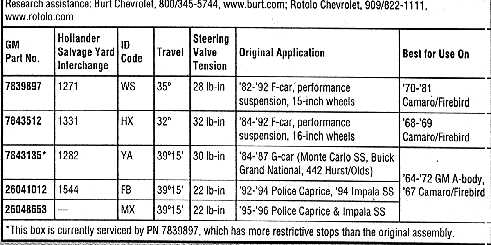
The "ID code is ink stamped on the box aluminum top or on the end plug.
Here is a link to info on swapping internal steering box parts.
Here is a link to steering coupler info
PS units have different size shaft than manual, Later (third gen up) PS boxes have smaller input shafts than first and second gen Camaros. Early is 13/16", 80 up, is 3/4".
Link to PS conversion using Kragen PS rebuilt for IROC
I recomend a good inline filter on your PS system, this one looks like a very good one, I don't like that it's plastic but with a proper cooler it should hold up. I really like the internal filter it uses.
Thery are available here at a good price, they also sell oil coolers
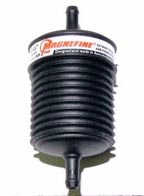
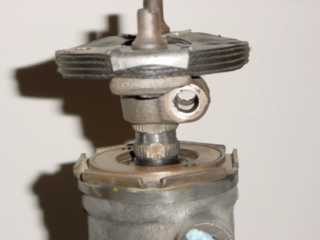 When installing the coupler and box, first center the box in it's
travel with the flat facing up, then align the shaft with the flat
spot as shown, this should be in the center of the boxes travel. Then
install the coupler as shown, with the head of the bolt pointing up,
except push it on all the way. The clamp bolt fits in the groove on
the shaft. When done this way the steering wheel will be aligned
correctly. The pitman arm should be pointing exactly toward the front
of the car.
When installing the coupler and box, first center the box in it's
travel with the flat facing up, then align the shaft with the flat
spot as shown, this should be in the center of the boxes travel. Then
install the coupler as shown, with the head of the bolt pointing up,
except push it on all the way. The clamp bolt fits in the groove on
the shaft. When done this way the steering wheel will be aligned
correctly. The pitman arm should be pointing exactly toward the front
of the car.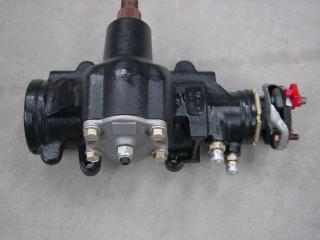 I added AN dash 6 hose adapters and a new Lee Coupler.
I added AN dash 6 hose adapters and a new Lee Coupler.

BELOW an early "Male" outlet fitting and pressure control valve. Note the slot in the "head" of the pressure valve. Drill the tip of the outlet fitting where it touches the pressure valve. Use a high quality colbalt type drill bit, - the valve is very hard at the tip. Pictured is the .140" drill a 9/64". Some outlet orifices are as small as 1/8"!
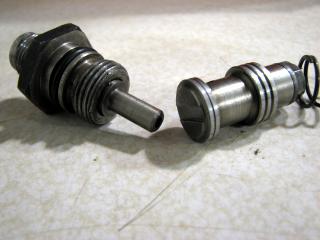
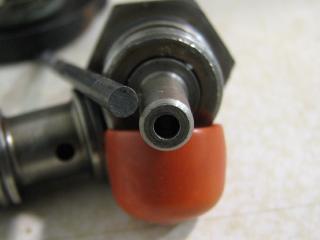
Drilling out the outlet restriction is pretty straightforward.
An article I have here from Lee Manufacturing says for the Z/28 box you need 2.75gpm. - 2.2 to 2.5 is stock.
It says to drill with a .147" drill which is #26 bit. The pump I had done by Lee Mfg was .157" and I have a stock one at .128" These are all the later style fittings, as in the photo above but early valves should use the same sizes. I'd drill to .147" and it should work OK.
Oversizing the restriction increases system heating and makes the
steering too responsive. On one system I drilled out the hole to 3/16"
and when turing the steering wheel and watching the tire, the wheel was
moving in tiny jerks. The restriction is there to control flow and
smooth out the pulses of the pump, too large a restriction makes the
response jerky.
Early Camaro pressures are usually 1000 psi or below, 1200 psi is needed for the new box.
The article says to remove ALL shims on the pressure valve, but one shim removed should be enough, you can allways remove more if needed. All shims removed will result in aprox 1400 psi.
Removing the little nut on the valve is very very hard to do without damage to the valve.
The method to remove the nut is to find a piece of aluminum tube that fits the OD of the valve, cut a notch out so it's a "C" shaped piece of tube with a 1/4 gap on the open end. Slide the valve inside and clamp it in a vise, unscrew the "nut" to change pressure setting shims.
Here is an article on PS pump pressure mods: http://www.hotrod.com/how-to/transmission-drivetrain/1209sr-power-steering-pump/
The tie rod end is not 90 degrees to the bolt holes so the exact
length will vary depending on how you measure it. Try to measure
level to the two steering arm mounting holes as shown below. Measure
from axle center line shown in white in the photo, to the top of the
tie rod stud.
RIGHT: This "short" outer arm -3954876 gives
you the
fastest ratio when used with the long pitman arm on the box.
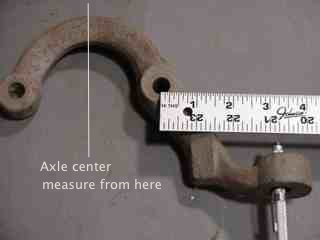
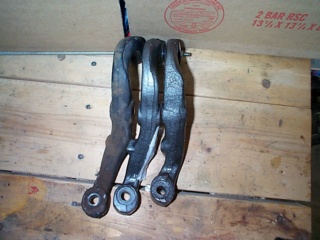
NOTE: these parts are fairly difficult to accurately measure for length. I have seen numbers that vary. Measuring from spindle center, I have used 5.25" and 5.8" for the long and short pitman arms. I have seen GM listings of 5.75 for the manual long pitman arm, and 5.312" for the short outer arms. But if you calculate the overall ratios with those lengths they don't come out and I have measured the long pitman arms and they are 5.8" not 5.75".
Remember, Nova, Ventura, Omega, up through 1974 uses the same subframe as Camaro.
SHORT 5.25" LH-3954875 RH-3954876 Used on power steer, and Z/28 fast ratio manual.
SHORT LH-3902519 RH-3902520 turn stop pad is more pronounced on top, arm appears a bit thinner than later arms. 1968
SHORT LH-3954879 RH-3954880 (listed in parts book as 5.312" long, this may be the actual correct length for all short arms)
SHORT JL8 four wheel disc arms, 1969 Z/28 Heat Treated, Shot Peened, (probably short 5.3") LH 3916237, RH-3916238
MEDIUM ARM 5.5" length RH-3916266 LH -3916265? not sure what ratio. 67 and into 68 manual steer.
MEDIUM ARM 5.5" length RH 3954874 LH3954873 - All except for PS and 302 1969 only.
LONG 6" manual, - LH-3902517 RH-3902518 (67, early long measured
at 6") LH-3917193 RH-3917194 slow ratio manual steering. (May have also been used on some PS equipped cars.)
MANUAL LONG 5.8", 3953225 (5671822 this number was given to me but not sure of it, does not start with 39xxxxx)
GM part number (casting number)
MANUAL SHORT 5.25", 3953217 (on part 3953219)
POWER LONG 5.8", 3953237 (3953227 on part late, - 3908391 1967 early-thinner)
POWER SHORT 5.25", 3935711-late -3935075 3953231-327 eng -early?
large OD PS center link - 3953221 :no longer available
all manual case casting numbers are 5679142 regardless of ratio for Camaro.
manual steering gear assembly Z/28 "special fast" 20 to 1 ratio fits 67 to 81 Camaro. 7806396
manual steering gear assembly 16 to 1 ratio Monza and Vega 7819935 might fit Camaro. Listed in "Chevrolet Power" parts book.
http://www.camaros.net/forum/Forum16/HTML/000527.html
I just found this tidbit in the August 1968 edition of "Chevrolet Service News", and thought it was interesting.
"1967 Camaro Manual Steering Gears Used in 1968 Production"
"In order to use up a surplus of 1967 Camaro manual steering gears, all 1968 Camaros equipped with manual steering built from May 22, 1968 to June 7, 1968 at the Norwood assembly plant [Serial Nos. N438680 through N448071] or from March 29, 1968 to July 23, 1968 at the Los Angeles assembly plant [Serial Nos. L338182 through L359064 (estimated final production serial number)] were built with the 1967 manual steering gears. Units incorporating these gears will also use 1967 steering arms, pitman arm and idler arm. Consequently, whenever it becomes necessary to replace one of the above mentioned affected components on a late built Camaro, check the serial number. If the serial number falls within the ranges given above, verify the existence of 1967 componets using the information given below."
The article then has a chart of part numbers to identify 1967 components.
Steering Gear Assembly....Daub of yellow paint on top
L/H Steering arm.....#3916265 forged on arm
R/H Steering arm.....#3916266 forged on arm
Pitman Arm.....#3908391 forged on arm
Idler Arm.....#3908385 forged on arm
Article continues:
"It should also be noted here that if power steering is installed in the field on a 1968 Camaro having the 1967 components, the pitman arm supplied with the 1968 conversion kit should NOT be used. Instesd use pitman arm, Part No. 3908379."
3744043 crank - double groove, low perf V8
3751232 crank - PS drive insert single, low perf V8
3890419 water pump double groove, low perf V8
3770509 PS pump low perf V8
Above came on my 67 327/275 with California smog pump, PS.
3858533 crank - double deep groove, Z/28 and HP
3765947 crank - double deep groove, PS drive insert Z/28 and HP
3770245 water pump double deep groove, HP V8
3720616 water pump pulley spacer shim - reinforcement
481042 PS pump - single deep groove perf, HP V8 (not stock, just something I found on an old pump)
3941105 PS pump - this is stamped steel, not cast iron
3956668 crank- two groove
392456 water pump single groove

Shown above, the deep groove 67/68 Z/28 water pump and crank pulleys are on the left, with the PS third groove insert pulley inside the crank double groove pulley. The center crank pulley is a smaller OD billet aluminum one I bought aftermarket, on the right are the stock low perf V8 pulleys, the crank double groove pulley has the PS third groove insert in it. In the foreground is the pump pulley for the low perf 327 #3770509.

LEFT front,- a high perf PS mount and adjuster bracket, this one clears the large OD high performance vibration damper on the crank. To the right front is a low perf bracket and pump with low perf stamped pulley. The low perf pump uses a different adjuster bracket, it bolts to the two front motor mount bolts. If the later interlocking engine mounts are used they can interfere with the bracket fitting on the lower hole, the interlocking tab is in the way.
To the rear, is the 69 style bracket. This bracket bolts to the long water pump which has a boss cast into it, the tensioner slot bracket bolts to the exhaust manifold (not shown).
The rear pump is a later pump, maybe a 1970, as evidenced by the larger rectangular reservoir.
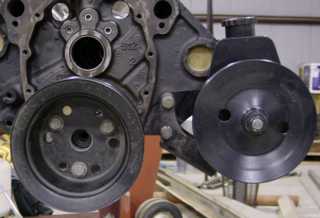
Above is my 67 high perf PS pump bracket. It will clear the large vibration damper with no mods.
Here is how one person converted his hoses to Aeroquip:
Teflon lined hose can also be used for pressure line. Normal Aeroquip line can be used for the low pressure return hose.
Went to Baer/Hotchkis/Flowmaster open track day.
It appears the early Camaro PS systems are not getting enough cooling to survive.
Most early Camaros have heating problems when driven hard on a track.
I talked to Lee Manufacturing today, and here are his comments.
At high RPM's the PS system is putting out about 20 times the volume that is needed. At that speed the hoses are becoming a restriction to flow.
There is so little total system volume, the fluid is really moving and heats up and foams the oil.
The pump should be run slower, but for a street car, the volume at idle may be too low to turn quickly enough!
Race cars run the PS pumps from 1/2 to 1/4 of engine speed.
Most Camaro pumps are 1 to 1 speed, or .92 of engine speed.
A larger PS pulley would be a good addition if the car will still steer at low rpm's.
A remote reservoir is good for a 30 to 60 degree reduction in temps. The suction hose on the bottom of the reservoir should be half inch dia and able to withstand suction of the pump.
Winston cup cars run PS temps of 300 to 350 degrees. Not that you would want to go that hot, but the WC teams won't spare any air flow to cool the steering.
A flat tube cooler is a bit better for cooling fluid. this would be a Serk, Mocal, or Earls Temp A Cure type oil cooler, but these coolers have flat sides where the fins connect similar to a water radiator. The PS fluid is vibrating rapidly and these coolers can vibrate too and make noise. The vibrations also can damage the cooler after years of vibration.
The round tube type cooler is not quite as good for cooling but less noisy and more durable.
A good cooler should be used with ample air flow through it. A good cooler will have a 4 to 5 degree temp drop from inlet to outlet.
Tony Huttmer showed us a neat PS reservoir with a cleanable screen filter inside.
You might consider a smaller crank pulley to reduce all accessories on the car, but cooling and charging may suffer if you slow them down too much.
Here is a link to a how-to rebuild page for PS pumps.
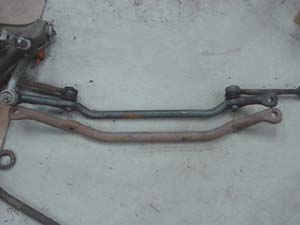 Upper
center link is a 67, lower is a 69 Power steering unit. I believe all
late and big block PS center links were the heavy type.
Upper
center link is a 67, lower is a 69 Power steering unit. I believe all
late and big block PS center links were the heavy type.
Small center link is .950"
Large center link is 1.125" GM#3953221
Rare Parts Inc. 923 El Dorado St
Stockton, CA 95206
Phone (800) 621-2005 in CA or (800) 621-2008
The Camaro restoration catalogs of Classic Industries and Year One sell this arm too.
Don't waste money on this expensive idler unless you really need it. The 68/69 replacements are only .25" longer at 5.5".
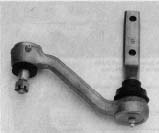 Rare Parts inc. won't sell directly to consumers, you may have to get
your parts store to deal with them for you.
Rare Parts inc. won't sell directly to consumers, you may have to get
your parts store to deal with them for you.
Both sides outer tie rod 67 ES348R (4.62" long)these are shorter than 68-69, don't know why, is adjuster sleeve longer on a 67?
Both sides outer tie rod 68-69 ES381RL (5.75" long)
Both sides Inner tie rod 67-69 ES681N
Toe in adjuster sleeve 68-69 ES350S
Upper ball joint K5108 67-69
Lower ball joint K5103 67-69
Upper control arm Shaft kit K5250
Idler arm + bracket K6099 all 68-69 5.375" long - cast iron, not forged steel.
Idler arm, K6093 all 67 5 3/4" long (no longer available)
Pitman, manual K6150 68-69 (short)
Pitman K6151 PS, short 5.25"
Pitman, PS K6154, 67-69 5.78" long (probably 5 3/4") 32 splines 1.1-1.18 diam. Not longer available from Moog.
Pitman, PS , long, Moog# 6582 New production run, early versions had no grease fitting, later do - Currently available at any auto parts store that sells Moog parts.
Pitman, PS long, TRW # 18770 Same as above. Probably a Moog part in a TRW box.
NOTE: There are two length pitman arms for power and two lengths for manual. Std 17 to 1 ratio power steering uses 5.25"
Optional fast ratio PS, uses 5.7" long Pitman arm.